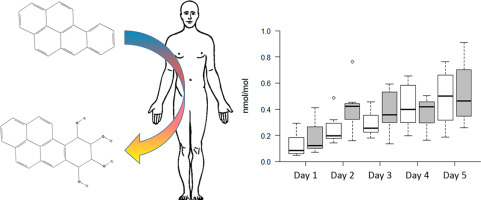Environment International ( IF 10.3 ) Pub Date : 2017-12-19 , DOI: 10.1016/j.envint.2017.12.012 Damien Barbeau , Simon Lutier , Luc Choisnard , Marie Marques , Renaud Persoons , Anne Maitre

|
Polycyclic aromatic hydrocarbons (PAH) are ubiquitous pollutants present as complex mixtures in the environment. Among them, benzo(a)pyrene (BaP) is classified as carcinogenic to humans by the International Agency of Research on Cancer. Taking into account all absorption ways, human biomonitoring allows PAH exposure assessment, but biomarkers both specific to carcinogenic effect and sufficiently sensitive are lacking. In this work, we proposed the urinary 7,8,9,10-tetrahydroxy-7,8,9,10-tetrahydrobenzo(a)pyrene (7,8,9,10-OHBaP) stemming from hydrolysis of BaP-7,8-diol-9,10-epoxide, the ultimate carcinogenic BaP metabolite, as biomarker of PAH exposure. A simple and highly sensitive analytical method, with a limit of quantification (LQ) reaching 0.06 pmol/L (0.02 ng/L), was described and validated. The relevance of urinary 7,8,9,10-OHBaP concentrations adjustment by creatinine was demonstrated. In a group of 24 non-occupationally PAH exposed subjects, only 15% of 7,8,9,10-OHBaP levels was below the LQ and the last daily void has been found as the best sampling time. Tobacco consumption had a significant positive effect on 7,8,9,10-OHBaP concentrations with a 90e percentile equal to 0.05 nmole/mole creatinine (nmol/mol) and 0.03 nmol/mol for smokers and non-smokers, respectively. In case of occupational PAH exposure, all the pre- and post-shift urinary 7,8,9,10-OHBaP levels of 7 non-smoking workers in a prebaked electrodes production plant were above the LQ. Concentrations ranged from 0.05 to 0.91 nmol/mol and accumulation of 7,8,9,10-OHBaP into organism of workers during the working week was clearly observed. The best sampling time was the post-shift at the end of week but samples should also be collected at pre-shift the beginning of week to assess the background level. Finally, the urinary 7,8,9,10-OHBaP elimination kinetic through the weekend was studied using non-linear mixed effect modelling. Mean apparent urinary half-life was 31.5 h with low inter-individual variability. Describing key characteristics of urinary 7,8,9,10-OHBaP as PAH exposure biomarker, this work should promote its use for future large-scale biomonitoring campaigns.
中文翻译:

尿反式-反-7,8,9,10-四羟基7,8,9,10苯并(一)芘作为评估致癌物质多环芳烃暴露最相关的生物标志物
多环芳烃(PAH)是环境中以复杂混合物形式存在的普遍存在的污染物。其中,国际癌症研究机构将苯并(a)re(BaP)归类为对人类致癌。考虑到所有吸收方式,人类生物监测可以评估PAH暴露,但缺乏对致癌作用具有特异性且足够敏感的生物标志物。在这项工作中,我们提出了尿7,8,9,10-四羟基-7,8,9,10-四氢苯并(apy(7,8,9,10-OHBaP)源自BaP-7,8-二醇-9,10-环氧化物(最终致癌的BaP代谢产物)的水解,是PAH暴露的生物标志物。描述并验证了一种简单且高度灵敏的分析方法,其定量极限(LQ)达到0.06 pmol / L(0.02 ng / L)。证明了肌酐调节尿中7、8、9、10-OHBaP浓度的相关性。在一组24位非职业性PAH暴露受试者中,7,8,9,10-OHBaP水平中只有15%低于LQ,并且发现最后的每日空隙是最佳采样时间。烟草消费对7,8,9,10 OHBaP浓度显著积极的影响与90 ê吸烟者和非吸烟者的百分位数分别等于0.05 nmole / mol肌酐(nmol / mol)和0.03 nmol / mol。在职业性PAH暴露的情况下,预焙电极生产厂中7名非吸烟工人的所有班前和班后尿中7、8、9、10-OHBaP的水平均高于LQ。浓度范围为0.05至0.91 nmol / mol,并且在工作周期间清楚地观察到7、8、9、10-OHBaP积累到工人的生物体内。最佳的采样时间是在周末结束时的轮班后,但也应在每周开始时的轮班前收集样品,以评估背景水平。最后,使用非线性混合效应模型研究了整个周末的尿中7,8,9,10-OHBaP清除动力学。平均表观尿半衰期为31.5 h,个体间差异低。











































 京公网安备 11010802027423号
京公网安备 11010802027423号